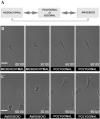Impact of elastic substrate on the dynamic heterogeneity of WC256 Walker carcinosarcoma cells
- PMID: 37735532
- PMCID: PMC10514059
- DOI: 10.1038/s41598-023-35313-2
Impact of elastic substrate on the dynamic heterogeneity of WC256 Walker carcinosarcoma cells
Abstract
Cellular heterogeneity is a phenomenon in which cell populations are composed of subpopulations that vary in their behavior. Heterogeneity is particularly pronounced in cancer cells and can affect the efficacy of oncological therapies. Previous studies have considered heterogeneity dynamics to be indicative of evolutionary changes within subpopulations; however, these studies do not consider the short-time morphological plasticity of cells. Physical properties of the microenvironment elasticity have also been poorly investigated within the context of cellular heterogeneity, despite its role in determining cellular behavior. This article demonstrates that cellular heterogeneity can be highly dynamic and dependent on the micromechanical properties of the substrate. During observation, migrating Walker carcinosarcoma WC256 cells were observed to belong to different subpopulations, in which their morphologies and migration strategies differed. Furthermore, the application of an elastic substrate (E = 40 kPa) modified three aspects of cellular heterogeneity: the occurrence of subpopulations, the occurrence of transitions between subpopulations, and cellular migration and morphology. These findings provide a new perspective in the analysis of cellular heterogeneity, whereby it may not be a static feature of cancer cell populations, instead varying over time. This helps further the understanding of cancer cell behavior, including their phenotype and migration strategy, which may help to improve cancer therapies by extending their suitability to investigate tumor heterogeneity.
© 2023. Springer Nature Limited.
Conflict of interest statement
The authors declare no competing interests.
Figures






Similar articles
-
The role of microtubules in electrotaxis of rat Walker carcinosarcoma WC256 cells.Acta Biochim Pol. 2015;62(3):401-6. doi: 10.18388/abp.2015_1019. Epub 2015 Jul 28. Acta Biochim Pol. 2015. PMID: 26217950
-
Lamellipodia and Membrane Blebs Drive Efficient Electrotactic Migration of Rat Walker Carcinosarcoma Cells WC 256.PLoS One. 2016 Feb 10;11(2):e0149133. doi: 10.1371/journal.pone.0149133. eCollection 2016. PLoS One. 2016. PMID: 26863616 Free PMC article.
-
Enhanced substrate stress relaxation promotes filopodia-mediated cell migration.Nat Mater. 2021 Sep;20(9):1290-1299. doi: 10.1038/s41563-021-00981-w. Epub 2021 Apr 19. Nat Mater. 2021. PMID: 33875851 Free PMC article.
-
The matrix environmental and cell mechanical properties regulate cell migration and contribute to the invasive phenotype of cancer cells.Rep Prog Phys. 2019 Jun;82(6):064602. doi: 10.1088/1361-6633/ab1628. Epub 2019 Apr 4. Rep Prog Phys. 2019. PMID: 30947151 Review.
-
Quantitative Clinical Imaging Methods for Monitoring Intratumoral Evolution.Methods Mol Biol. 2017;1513:61-81. doi: 10.1007/978-1-4939-6539-7_6. Methods Mol Biol. 2017. PMID: 27807831 Review.
Cited by
-
Epithelial-mesenchymal plasticity in cancer: signaling pathways and therapeutic targets.MedComm (2020). 2024 Aug 1;5(8):e659. doi: 10.1002/mco2.659. eCollection 2024 Aug. MedComm (2020). 2024. PMID: 39092293 Free PMC article. Review.
-
Methodological study of fibroblasts MEF 3T3 heterogeneity cultured on hydrogel substrates with different surface functionalization.bioRxiv [Preprint]. 2025 Jun 17:2025.06.12.659070. doi: 10.1101/2025.06.12.659070. bioRxiv. 2025. PMID: 40667183 Free PMC article. Preprint.
References
Publication types
MeSH terms
LinkOut - more resources
Full Text Sources

